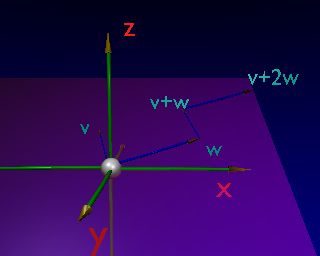 The vectors x, y and z
form the standard basis
of 3D space (of R^3) and are not too important to this example.
They are drawn in just for reference. I will explain the word
"basis" later.
The vectors x, y and z
form the standard basis
of 3D space (of R^3) and are not too important to this example.
They are drawn in just for reference. I will explain the word
"basis" later.| A Subspace and a Basis |
This page is a preview of some ideas from Ch 3.
 The vectors x, y and z
form the standard basis
of 3D space (of R^3) and are not too important to this example.
They are drawn in just for reference. I will explain the word
"basis" later.
The vectors x, y and z
form the standard basis
of 3D space (of R^3) and are not too important to this example.
They are drawn in just for reference. I will explain the word
"basis" later.
The tilted purple plane is an example of a subspace "S" of R^3. It is hard to draw clearly, but S contains the x-axis and the two small blue vectors v and w (maybe hard to see). It extends forever and doesn't have borders.
I have drawn in some linear combinations of v and w, such as v + w and v + 2w to show that they are all in S. This is what makes S a subspace.
In fact, every vector in S is a linear combination of these two. [For example, I mentioned earlier that x is in S, so it must be a linear combination. And I'd estimate that x = 1.3w - 1.3v (approx)]. So, we say that v and w span S. The set of all linear combinations of v and w is called span(v,w). So, S = span(v,w). For the same reason, we call v and w a spanning set for S. [Check visually that v and x also form a spanning set of S.]
The three vectors x, v and w form a spanning set of S, too [It's even easier to make linear combinations when you have all three vectors] But it's not effiicient to use 3 when you can use 2. These three do not form a minimal spanning set, (or basis) like {v,w} does. While some people use this as a definition of basis, we will not.
For us, a basis is a spanning set that is linearly independent. The precise definition of that phrase is a little tricky, and can wait, but it means (approx) that none of the vectors in the spanning set are combinations of the others. For example, we saw that x is a combo of v and w. So, the set {x, v, w} is linearly dependent, and not a basis.
The set {v, w} doesn't have this problem and is a basis of S. In fact, a set of just two vectors is always linearly independent unless one is a multiple of the other (which means they are parallel). To test your understanding, think about why {x, y, z} is a basis for R^3.
Please read this over a few times, and try to retain some of the vocabulary. But do not assume that you know anything yet! I haven't scratched the surface. Learning the precise definitions and using them correctly will be quite important later.